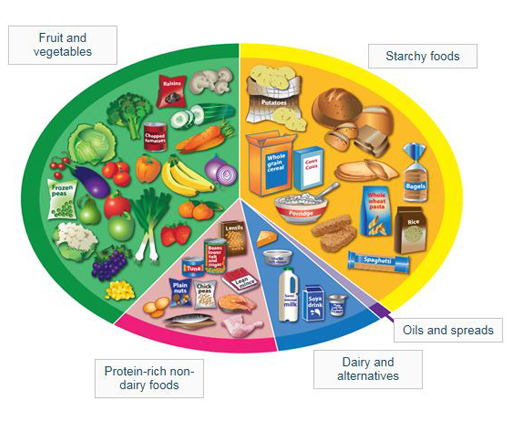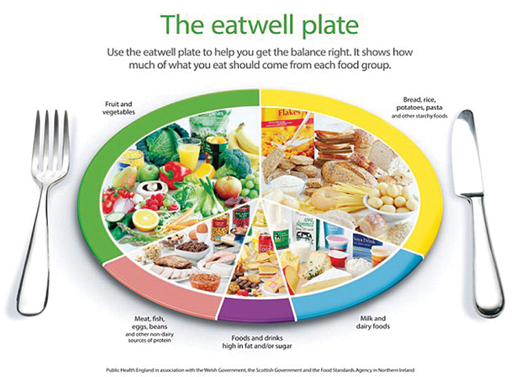1 The Eatwell Guide
There have been various attempts to try to show the constituents of a healthy eating pattern to the general public in the UK. The Eatwell Guide (Figure 1) is a policy tool used to define government recommendations on eating healthily and achieving a balanced diet. It is commonly used and what the government portrays as a visual tool towards healthy eating.
The government website states:
The Eatwell Guide is a policy tool used to define government recommendations on eating healthily and achieving a balanced diet.
You may notice that not only is food included but also fluid intake. Sweet and savoury snacks are not within the daily suggested proportions and fats are the smallest part. There is information about labelling with a suggestion for choosing foods that are lower in fat, salt and sugars.
The Eatwell Guide is not suitable for children less than 2 years old. From 2 to 5 years, it is expected that children are eating family meals in the same proportions as in the Eatwell Guide.
Activity 1 Understanding the Eatwell Guide
Click on the following link where you will find the details on how to use the Eatwell Guide and more about the different food groups. Read the document here (Public Health England, 2016a) [Tip: hold Ctrl and click a link to open it in a new tab. (Hide tip)] and then answer the following questions. Drag each answer into the correct slot.
Using the following two lists, match each numbered item with the correct letter.
-
Answer: 80 g
-
Some examples are vegetarian meat e.g. mycoprotein-based, soya, beans, pulses, eggs,
-
One portion
-
No more than 30 g per day which is seven cubes of sugar.
-
It used to be the Eatwell Plate but in 2016 this changed to the Eatwell Guide.
a.What is the maximum amount of free sugar recommended for adults?
b.How much oily fish should you eat in a week?
c.How have the recommendations changed?
d.If you are vegetarian, what protein sources can you have?
e.What is the weight of one portion or fruit or vegetable?
- 1 = e
- 2 = d
- 3 = b
- 4 = a
- 5 = c
You might remember the Eatwell Plate (Figure 2), so why did it change?
Look at both versions and write down in the box below what you see is different. What did you notice?
Answer
You may have noticed:
- The knife and fork is no longer used.
- The proportions have been changed.
- The pictures are not of real food.
- High sugar and fat snacks have been removed.
- Hydration is included in the new Eatwell Guide.
- There is some guidance on food labelling in the new Eatwell Guide.
- The recommended energy levels for males and females is included in the new Eatwell Guide.
There is detailed information about why the Eatwell Guide was developed and replaced the Eatwell Plate on the Public Health England website (2016b).
Do you think the Eatwell Guide is useful?
Write two or three sentences in the box below. Click ‘Save’ when you are satisfied with what you have written.


